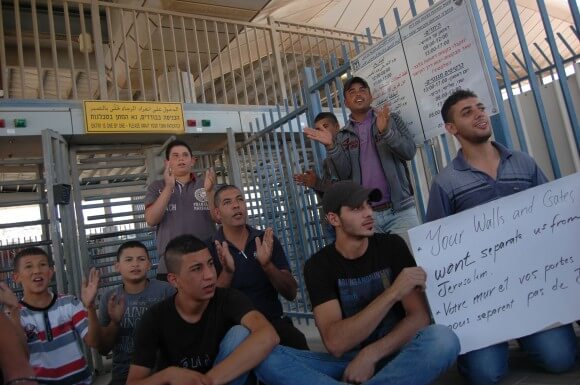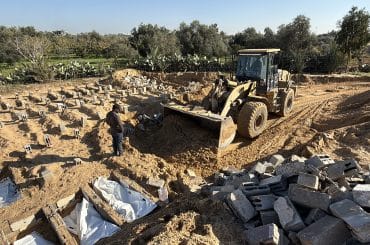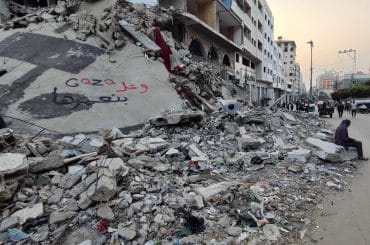
I’m standing in Jerusalem, but behind a five-lane, metal turn-stop, gated, chain-linked, barbed-wire military instillation. There’s a call box with a button to alert the Israeli army when pedestrians want to pass. Even though I’m in a valley between windswept hills with cinder block houses and black water tanks on their roofs, I feel more like I’m in the parlor of Satre’s No Exit; sometimes the guards answer the buzz of the button, and sometimes the gates roll open, otherwise the checkpoint is locked. And I never know if I can pass through the gate, unless I try to push the metal bars forward. I wonder am I waiting for the checkpoint to open, or is it already open and I just haven’t tried to leave? Am I trapped, or do I imagine that I am trapped?
Welcome to a-Zeitim crossing, one of the newer divisions inside of Jerusalem. Although hailed as an undivided capital, where Jewish-Israelis can trot from neighborhood to neighborhood, increasingly intractable metal is constructed between Palestinian localities. Like plantar warts, these checkpoints spread on the ridges and lowlands, hidden unless I look for them. Before last week I hadn’t heard of a-Zeitim, probably because cars can’t drive through, only foot traffic. And this checkpoint is nestled between Palestinian residential areas in the periphery of Jerusalem.
The checkpoint forces Palestinians to walk through a hard corridor when strolling from Abu Dis to At-Tur. The two areas once were adjoining neighborhoods, like Greenwich Village and Chelsea, but now Jerusalem ID holders (a special status for Palestinian residents of Jerusalem who are not citizens of Israel, nor the West Bank) are separated by the infrastructural might of the Brooklyn bridge: a tower, a concrete fence and this checkpoint.

“Before the start of the popular resistance groups we worked with the Fatah movement, and we knew people from the Jahalin Bedouin villages from that time,” said Thaer Anis, 36, a civil servant with the Palestinian Ministry of Finance. Anis spoke to me next to a chain-linked fence that encircles the parking lot of a-Zeitim checkpoint. He had just gotten out of jail about a month before, arrested for knocking out a piece of the separation barrier in a protest commemorating the Palestinian nakba earlier this year. In the intervening five months he and a number of his co-organizer with a group called Bab al-Shams have all been locked up for destroying pieces of the wall.
Anis was picked up in one of the West Bank’s largest military incursion of the year, when 200 border police stormed Abu Dis and nearby Eizariya and arrested 11 for tampering with the wall.
After Anis was incarcerated, others continued to break off pieces of the barrier. Many of them, like Anis, were later arrested in the dead of night. The Israeli military has security cameras. “They took a picture of me when I broke the wall,” said Anis, who was eventually charged with tampering with security barrier and the photograph surfaced in trial as definitive evidence against him.
But Anis’s three-month stint in jail didn’t deter the young professional and activist. He’s back to protesting Jerusalem’s divisions. Like many other Palestinians from areas of the holy city that are now trapped behind the wall, Anis has to drive to a further checkpoint to access the rest of the city, called a-Zayyam, which borders area E1, Jerusalem and the West Bank. Part of the village that the checkpoint takes its name from is also split between Jerusalem and the West Bank. Last year when I visited a-Zayyam I noticed all of the cars had Israeli yellow license plates rather than green Palestinian Authority plates. Yet everyone in the village said despite mostly falling in Jerusalem’s municipal borders, no one services the village: not Israel or the West Bank. They burn their own trash and purchase water in large tanks.


With most of the wall-breakers now out of jail, Anis and his neighbors are trying a different tactic to protest the strangulation of their neighborhoods that comprise the outer lands of both Jerusalem and the West Bank. Last week after Friday prayers, others from Abu Dis and Eizariya joined him and me. They dropped to their knees on rugs in front of a-Zeitim checkpoint. This is their new demonstration; praying at the checkpoint. They took the name “Bab al-Shams,” after a protest village erected last fall inside area E1 on private Palestinian owned land that garnered the attention of international media, because many of these activists helped construct that village and live nearby the former location of Bab al-Shams.
Last year I reported on Bab al-Shams and four other protest villages that followed. At the time much of the media coverage paralleled Bab al-Shams with settlers who construct illegal outposts to create “facts on the ground.” But a striking difference between the settlers and these Palestinians is that the Palestinians held titles to their land, and settlers try to acquire deeds by building new communities first.
Moreover, the activists at Bab al-Shams and the other protest villages violated no Israeli laws. The organizers smartly constructed with materials that do not require permits, namely tents. When they were eventually evicted, it was through a closed military zone order, the first of which was directly decreed by Prime Minister Benjamin Netanyahu himself.
At first glance Anis’s group’s checkpoint prayer-protest struck me as a conglomerate of issues heaped together: children held signs about access to al-Aqsa mosque, the checkpoint itself was rallied against and there was informal discussion over a government program to transfer Jahlain Bedouin from area E1 to a reservation next to the Abu Dis dump yard. “Because it’s area E1, the Jahalin live here too and we work together,” explained Anis. In fact a-Zeitim checkpoint borders area E1, as well as Jerusalem and the West Bank. It is a checkpoint of crossings between difference administrative areas, where Palestinians live with every kind of status imaginable. Some are Israeli citizens, some are Jerusalem residents, and some are West Bank residents.
Even for those who live near a-Zeitim checkpoint, the exact line of 1967 border isn’t always clear. An infamous example is the Cliff Hotel in Abu Dis, which in recent years has been taken over by the Israeli military. The hotel was part of the construction boom in East Jerusalem’s neighborhoods after the Oslo Accords were signed. Back then the owners thought in earnest a Palestinian state was around the corner and so it was a promising time to invest in building a hotel to serve the future capital.
“The kitchen was in the West Bank,” said Anis’s co-organizer, Dr. Abdullah Abu Hillal, 39, a general practitioner and a member of the Palestine National Initiative, the political party headed by Dr. Mustafa Barghouti, who fell victim to the perils living in a divided neighborhood. Dr. Abu Hillal was arrested in 2006 at the hotel for inadvertently entering Jerusalem without a permit. With half of the structure in Jerusalem and half in the West Bank, Palestinians guests were crossing the Green Line when moving from room to room. When told he was in Jerusalem and had illegally entered Israel, Dr. Abu Hillal tried appealing to the arresting officer, asking which part of the hotel was in the West Bank and that he would go there to avoid detention. “The army refused because he said I didn’t have the right ID.”

For the first 35 years of Israel’s now 46-year occupation in Abu Dis and other cities that the Green Line traversed, the borders were relatively inconsequential. The Green Line was not sealed up near Palestinian population centers the way it is today, with over 70 military checkpoints in the West Bank and seven in the Jerusalem area, alone. Then when the separation barrier construction began, Abu Dis was one of the first Jerusalem neighborhoods to have the concrete divider slice through the locality. And like most of the path of the wall, in Abu Dis it doesn’t actually follow the route of the Green Line. So what exists today is a panel of division inside of holy city, separating one section of the Jerusalem from the rest of the promised capital city.
While supporters of Israel hail the post-Oslo checkpoints as cages to weed out potential security threats with their rigorous ID checks and biometric scanners, and critics decry the devastation to West Bank Palestinian economy and mobility, few lay their attention on the checkpoints inside of Jerusalem, like a-Zeitim. There are 250,000 Palestinian East Jerusalem ID holders who pay taxes to Israel, vote in municipal elections, and are at constant risks of losing their privileges inside of the Israeli system. Together they are 40 percent of the total city’s population. But after the beginning of the separation wall’s construction in 2002, an immobilizing barrier more often than not situated over the Green Line has rendered ghettos inside of Jerusalem. A-Zeitim, the olives terminal, therefore has become a doorway to a Jerusalem ghetto. And entering and exiting from one neighborhood to the next is a bizarre hell that is only imposed on Jerusalem’s Arab population.


Israeli anti-semitism at work, building the largest Jewish ghetto in history.
Just how much worse is the truth about ghetto-Israel that these people are driven to lock themselves, by themselves, voluntarily, away from humanity behind such contraptions?
The checkpoints stop the suicide bombers,why no mention of this.
http://en.m.wikipedia.org/wiki/List_of_Palestinian_suicide_attacks
Have you ever notice the paucity of women in Arab activist photos? I am not saying there are NO female activists. I am noticing how patriarchal Arab society still is.
The problem is such details of Palestinian life under Jewish Israeli rule over the years matter less to most Americans than whether or not Redskins is an OK name for a sports team, or, more likely, whether they will be eating burgers or cheesy noodles for supper–and do they have enough foodstamps for the remainder of the month?
Stop telling half truths. The checkpoints did not exist from 67 untill 90-‘es (apart perhaps very few and far between being very primitive and manned by sleepy reserve soldiers). The modern ones in such numbers were erected to stop suicide bombers.
To stop them from killing Jews. And often Arabs too. Civilians, men and women and children.
Look at the Wikipedia under “List of Palestinian suicide attacks”
http://en.wikipedia.org/wiki/List_of_Palestinian_suicide_attacks
and see this awful list.
No country, no government can allow this to happen. The Wall and the checkpoints were erected to stop these attacks and are extremely effective at this.
When millions of travelers in US and EU and the rest of the world airports are waiting in long lines to be checked like cattle or refugees or beggars with their shoes in hands and pants with belts removed and unfinished bottles of Coke taken away – it is for the same reason – fear of Arab suicide bombers.
Why don’t you relate in a similar way detailed stories of those long delays and humiliations which these travelers go through. Because they are needed.
So stop telling half truths. What do you think we have spare money to built all these monsters? And to man them? Stop lying to yourself. Not to others – to yourself.
On a general note – understand that the main reason Palestinians and surrounding Arab states kept loosing to us over all these 65 years was precisely because of that – they were lying to themselves, to each other, not only to others and they began to believe in those lies.
We always looked in the eyes of the truth. Also now – we see the truth. We know our problems. Half of the links which are provided on this blog are to Israeli press. Have you thought about it?
We know the facts, we are used to the truth and are not afraid of it. You are. Otherwise you would not tell half-truths like you do. Or often full lies.
We will fix things, fix our problems because we know what to fix. I can’t tell how but we will.
You here and in similar places try to create a virtual reality. Arabs did the same and they lost. And you now follow them or perhaps are even guided by them and you will lose too. Look into the eyes of the truth. Not half of it.